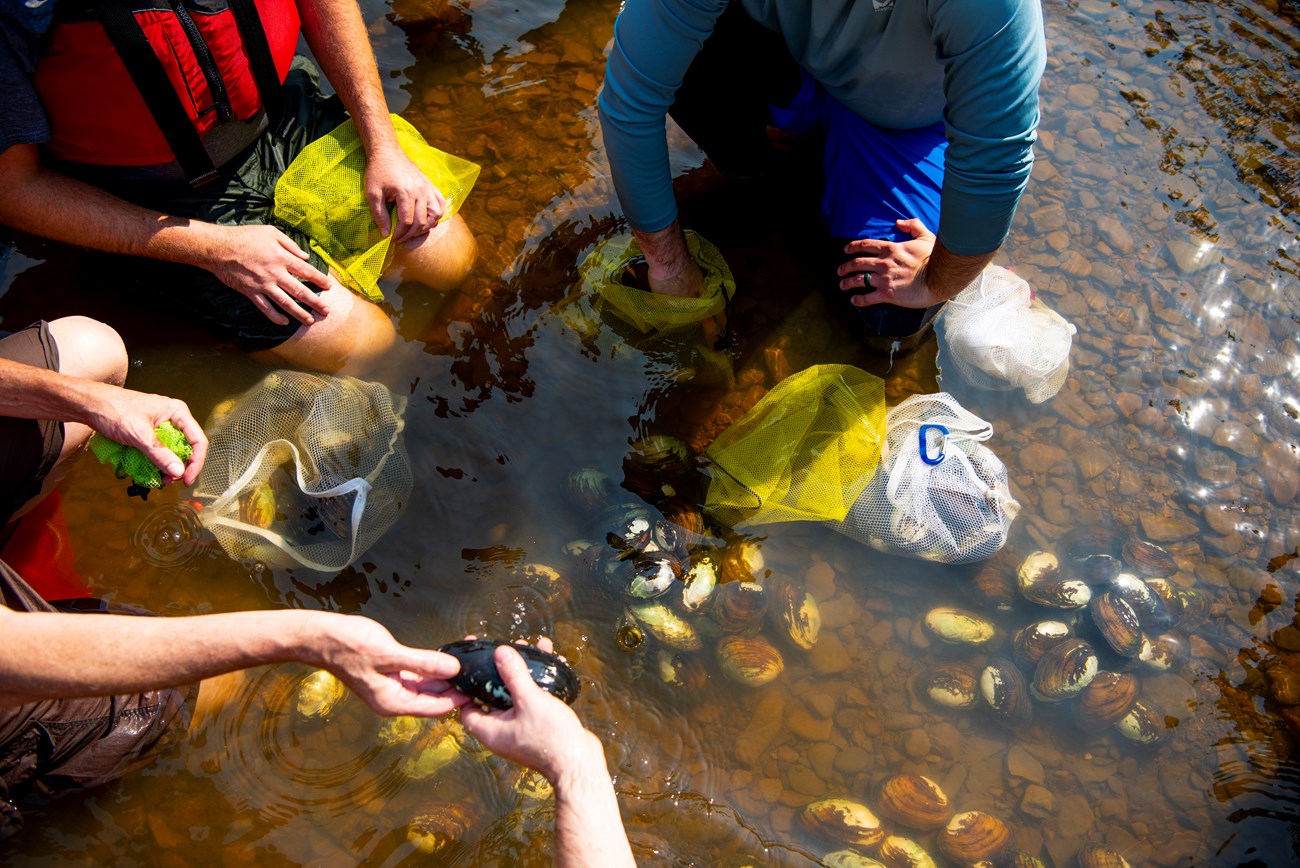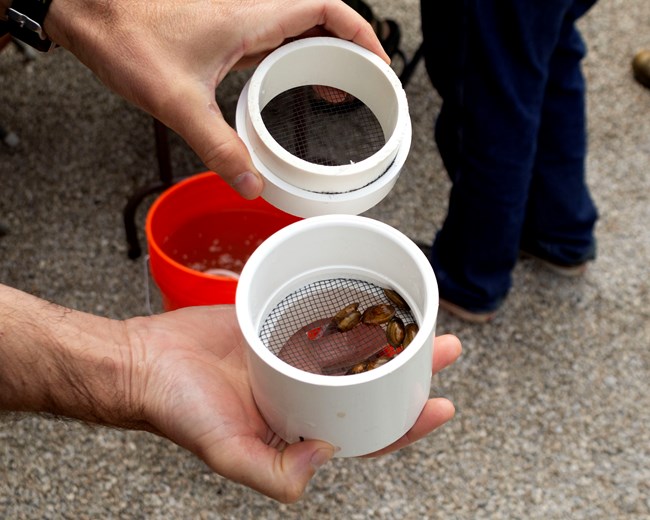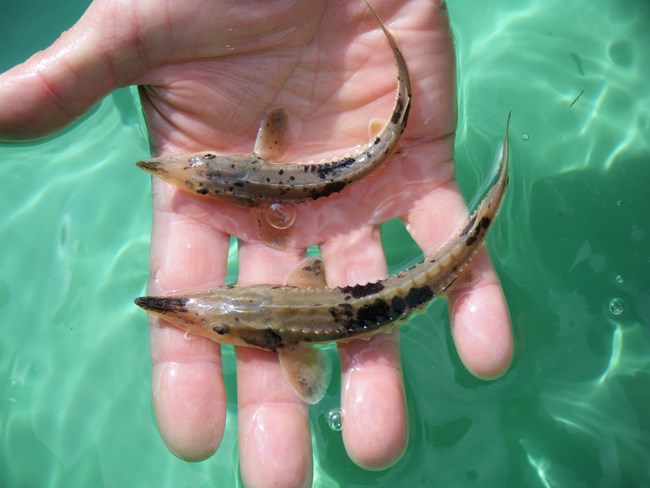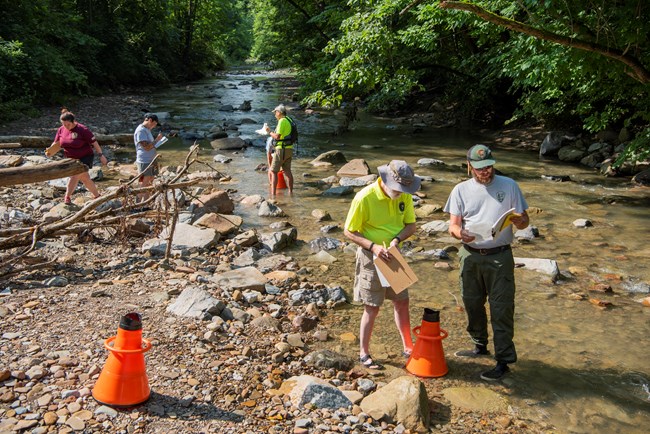Last updated: September 16, 2025
Article
Can the Cuyahoga River Support Rare Wildlife?

NPS / Ryan Grzybowski
Imagine the river in Cuyahoga Valley back in the 1970s. Detergent bubbles clogged the bend in Peninsula. Catching a carp near Station Road was considered lucky. On bad days, a funk hung in the air from Akron’s water treatment plant. Fast forward to today when bald eagles, otters, and great blue herons are regularly seen raising their young. Kayakers paddle the Cuyahoga River Water Trail past the site of former dams in Brecksville. Could it get any better?
It just might. In 2021, the National Park Service and its partners began two projects that were unimaginable back in those early days. Both explore whether the river can now support some of Ohio’s rarest forms of aquatic life. So far, the answer has been "yes."
After years of studies, preparations, and collaboration, the inaugural reintroductions of lake sturgeon and one freshwater mussel species are in fall 2025.

NPS / Demarco
Bringing Back Freshwater Mussels
It’s easy to mistake our native mussels for rocks. However, their unassuming looks belie their importance—they are actually rock STARS. According to the US Fish & Wildlife Service and The Nature Conservancy, North America has the greatest diversity of freshwater mussels in the world. The largest concentration is here in the Midwest. Unfortunately, mussels are also our most imperiled group of animals. The adults are sedentary filter feeders. Most cluster in communities called mussel beds that can support 30 or more species. Mussels can live for decades, and sometimes a century or more. This makes them vulnerable to long-term changes in our waterways.
Because of a quirk in their reproduction, freshwater mussels are also good indicators of how healthy certain fish populations are. A female mussel protects her fertilized eggs in a special gill pouch. When the time is right, she uses a specialized lure to attract a host fish and then squirts the unsuspecting babysitter with tiny larvae. The larvae hitchhike for a few weeks in the fish’s gills or fins and then drop off in a new territory. Mussels are out of luck if the right fish aren’t around, or the water is too polluted, or rapid flows wash away the riverbed where the larvae would attach.
In late July 2021, a team of scientists led by the National Park Service (NPS) in collaboration with the US Army Corps of Engineers, Cleveland State University, and other local partners collected a small number of muckets (mussels have the coolest names) from the Grand River and relocated them to the Cuyahoga. This pilot confirmed that mussels can survive in the Cuyahoga.
In 2022, a team released groups of mussels in concrete silos in the river. The mussels are inside of a chamber with mesh ends that allows water to filter through. These silos also allow park staff to monitor these groups of mussels to determine if reintroduction is appropriate in the coming years.
Here are the more recent project milestones:
- Scientists conducted habitat modelling to identify good areas for mussel reintroduction.
- National Park Foundation funded NPS to propagate fatmuckets to be released in the park for the purpose of establishing freshwater mussel beds.
- September 2025 is the first stocking of more than 600 individual fatmuckets propagated at Genoa National Fish Hatchery by the US Fish & Wildlife Service.
- The project also funds researchers at Cleveland State University to study the habitat and success of reintroduction efforts. Reintroducing mussels into an areas where they were completely lost has only been tried a few times. Recent attempts include efforts at Indiana Dunes National Park. We have a lot to learn and use adaptive management to ensure the success of this program.

US Fish & Wildlife Service
Finding a Home for Sturgeon
A second multi-agency team led by the US Fish & Wildlife Service mapped the riverbed to see if the Cuyahoga has the right habitats to support lake sturgeon. They looked at the entire lower half, from the Gorge Dam to the mouth in Cleveland. These unusual fish are uncommon in Lake Erie. The most striking thing about them is that they have rows of heavy, bony plates instead of scales. And they can live to be 150 years old and reach up to 300 pounds! Historical records show that lake sturgeon used to be common in Lake Erie and would travel up the Cuyahoga to spawn. These fish need places with a pebbly bottom where females can lay their eggs, as well as sandier spots where young hatchlings can find food.

NPS / Ryan Grzybowski
In early spring 2021, US Fish & Wildlife Service staff floated downriver with a side scan sonar. This technology mapped the natural materials that make up the Cuyahoga’s riverbed. Over that summer, they trained national park staff and volunteers on how to “ground truth” the sonar images. Basically, we helped with the field work to see if underwater patches of sand, gravel, pebble, or bedrock are accurately identified in the sonar data. To do this, team members used an underwater viewer called a bathyscope—think orange safety cone meets snorkeling mask. This habitat study was one of the first steps in determining if the Cuyahoga can support a reintroduction of lake sturgeon. Scientists found that there are places suitable for reproduction and for newly hatched fish. This work builds on projects in the Maumee River near Toledo and other Lake Erie tributaries.
On October 4, 2025, 2,000 lake sturgeon are being stocked in three locations along the river. These are Rivergate Park in Cleveland, Boston Store Trailhead River Access in Cuyahoga Valley, and the Valley View Area of Cascade Valley Metro Park in Akron. The public is invited to participate. The plan is to stock 1,500 annually for the next 20 plus years. Stocking locations may change in the future.
Ohio Division of Wildlife is the lead agency on the sturgeon project but strong partnership and collaboration with US Fish & Wildlife Service is required. NPS, Cleveland Metroparks, Summit Metro Parks, Northeast Ohio Regional Sewer District, and other local partners are supporting this effort as well.
For more information, visit the Ohio Division of Wildlife’s lake sturgeon page. There you can find the final Cuyahoga River Lake Sturgeon Reintroduction Plan, background information, and a lake sturgeon reporting tool.
Healthy Water, Healthy People
Whether you get excited about wildlife or not, consider what this means for Ohio and for Lake Erie. Greening the Rust Belt is a heavy lift. Improving the health of the Cuyahoga River is part of an international effort to restore the most polluted areas in the Great Lakes. None of this would have been possible without the Brecksville dam removal here in Cuyahoga Valley. It “opened the floodgates,” making these projects and the designation of the Cuyahoga as a state and national water trail possible. Each success shows our strength and commitment to a better future for all forms of life, including people.

US Fish & Wildlife Service
Tags
- cuyahoga valley national park
- midwest
- ohio
- biodiversity
- animals
- wildlife
- wild animal
- endangered species
- fish
- mussels
- sturgeon
- resource management
- natural resource management
- natural resources
- research
- park science
- science
- recovery
- connected conservation
- collaborative conservation
- conservation partnerships
- river
- cuyahoga river
- great lakes
- lake erie
- aquatic life
- dam removal
- river restoration
- river renewal
- water quality
- clean water
